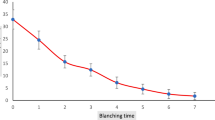Abstract
Jaggery samples were prepared from sugarcane juice having different concentrations of reducing sugars (by adding glucose/fructose) for studying the contribution of invert sugars towards colour development of jaggery by non-enzymic browning reactions during jaggery making process. Addition of 0.5 and 1.0 g glucose/100 ml cane juice did not alter the colour of juice after boiling for 30 min at 98 °C, while addition of same quantities of fructose/100 ml in the cane juice enhanced the colour of boiling juice over control. Further, evaporation of cane juice till 118 °C for preparation of jaggery indicated that the colour of jaggery samples prepared from juice having additional 0.5 and 1.0 g fructose/100 ml juice increased indicating more contribution of fructose towards darkening of colour development of jaggery during thermo-evaporation process. As the pH of juice remained below 6 through out the jaggery making process, fructose of cane juice seemed to be contributing more towards colour of jaggery in comparison to glucose in the non-enzymic browning. This was indicated by significantly more colour development by caramelization of fructose at 118 °C in comparison to glucose and sucrose since carbonyl–amine browning does not take on much significance until the pH is greater than 6.



Similar content being viewed by others
References
Agarwal, M.L., S.P. Dua, and G.S. Dixit. 1988. Manufacture and storage of gur in India-a review. Bharatiya Sugar 13: 45–50.
Anon. 2005. Utilization of sugarcane for different purpose. Cooperative Sugar 36(6): 516.
Babsky, N.E., J.L. Toribio, and J.E. Lozano. 1986. Influence of storage on the composition of clarified apple juice concentrate. Journal of Food Science 51(3): 564–567.
Burton, H.S., and D.J. McWeeny. 1963. Non-enzymic browning reactions: Consideration of sugar stability. Nature 197: 266–268.
Burton, H.S., D.J. McWeeny, and D.O. Biltcliffe. 1963. Non-enzymic browning—development of chromophores in glucose-glycine and sucrose-glycine systems. Journal of Food Science 28: 631–639.
Chisari, M., R.N. Barbagallo, and G. Spagna. 2008. Characterization and role of polyphenol oxidase and peroxidase in browning of fresh-cut melon. Journal of Agriculture and Food Chemistry 56: 132–138.
Ghosh, A.K., and M.P. Agarwal. 1983. Gur grading based on physical and chemical constituents. Maharashtra Sugar 8(12): 39–43.
Ghosh, A.K., A.K. Shrivastava, and V.P. Agnihotri. 1998. Medicinal uses of gur. In Production technology of lump sugar Gur, ed. A.K. Ghosh, A.K. Shrivastava, and V.P. Agnihotri, 271–278. Delhi: Daya Publishing House.
Hodge, J.E. 1953. Chemistry of browning reaction s in model systems. Journal of Agriculture and Food Chemistry 1: 928–943.
Honig, P. 1953. Chemical reactions in the settling of limed cane juices. Proceedings of the ninth congress of the International Society of Sugarcane Technologists 9(2): 583–594.
Irwine, J.E. 1977. Composition of cane and juice. In Cane sugar handbook, 10th ed, ed. G.P. Meade, and J.C.P. Chen, 15–29. New York: Wiley.
Kapur, J., and R.S. Kanwar. 1983. Studies on storage of gur in Punjab. Maharashtra Sugar 8: 45–49.
Kumar K. 1999. Oscillations in Jaggery and Khandsari industry, Proceedings of the natural seminar on status, problems and prospects of jaggery and khandsari industry pp 87.
Roy, S.C. 1951. Monograph on gur industry of India, 18–43. Kanpur: I.I.S.T.
Schroeder, L.J., M. Iacobellis, and A.H. Smith. 1955. The influence of water and pH on the reaction between amino compounds and carbohydrates. Journal of Biological Chemistry 212: 973–983.
Shallenberger, R.S., and G.G. Birch. 1975. Intrinsic chemical reactions of the sugars. In Sugar chemistry, ed. R.S. Shallenberger, and G.G. Birch, 89–112. Westport, CT: Avi Publishing Company, Inc.
Tomasik, P., M. Palasinski, and S. Wiejak. 1989. Thermal decomposition of carbohydrates: Part I-the decomposition of mono-, di and oligosaccharides. In Advances in carbohydrate chemistry and biochemistry, ed. R.S. Tipson, and D. Horton, 203–255. San Diego, CA: Academic press, Inc.
Acknowledgments
Authors thank the Director, Indian Institute of Sugarcane Research, Lucknow, for providing facilities and constant encouragement.
Author information
Authors and Affiliations
Corresponding author
Rights and permissions
About this article
Cite this article
Banerji, R., Singh, P., Anwar, S.I. et al. Effect of Reducing Sugars on Non-enzymic Browning During Thermo-Evaporation of Sugarcane Juice for Making Jaggery. Sugar Tech 14, 428–431 (2012). https://doi.org/10.1007/s12355-012-0159-8
Received:
Accepted:
Published:
Issue Date:
DOI: https://doi.org/10.1007/s12355-012-0159-8




